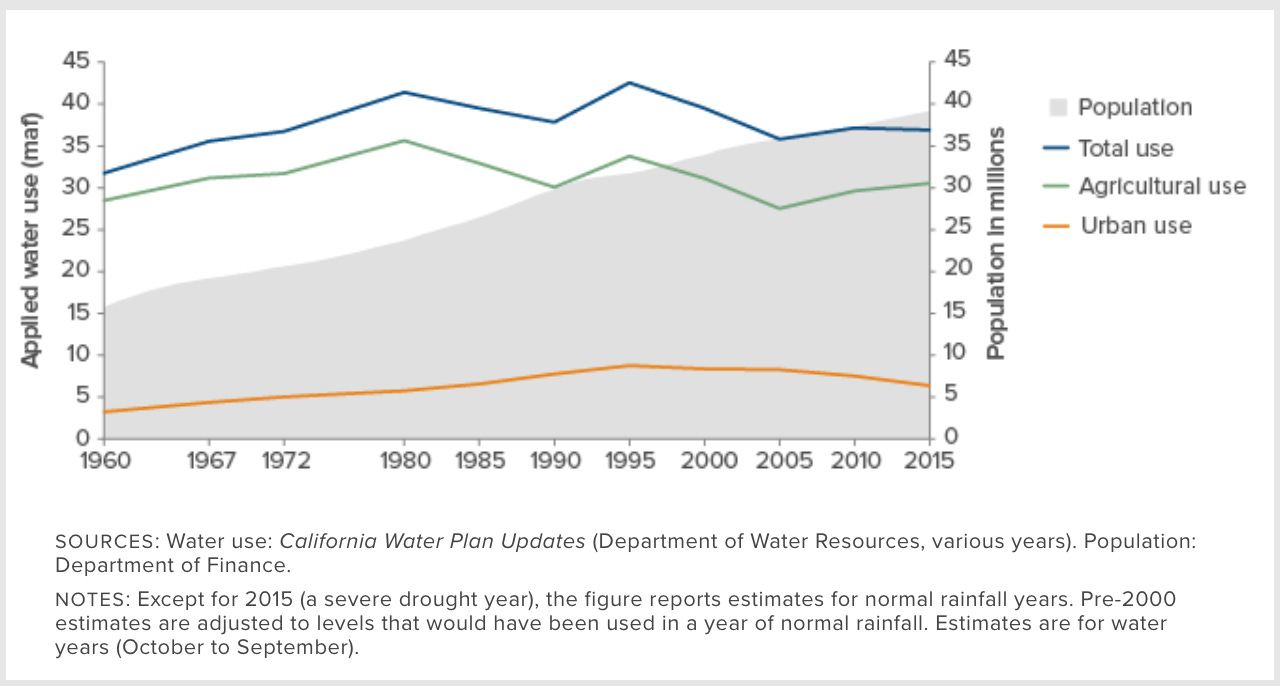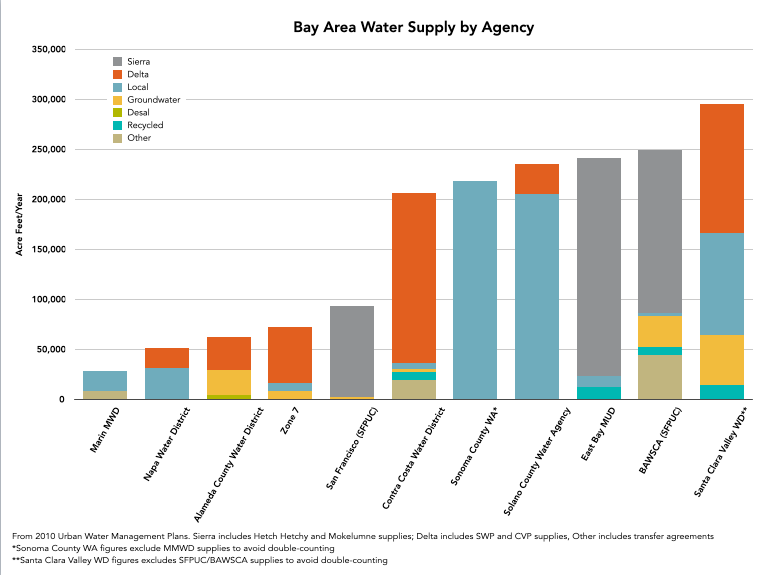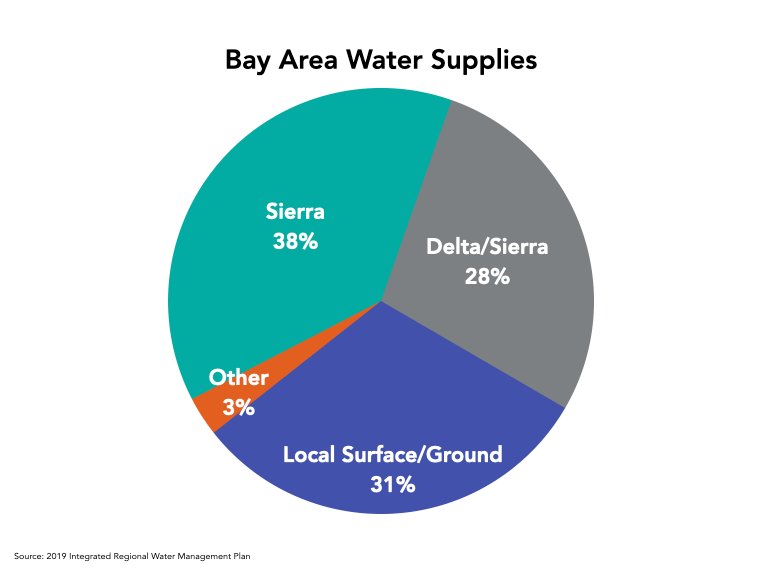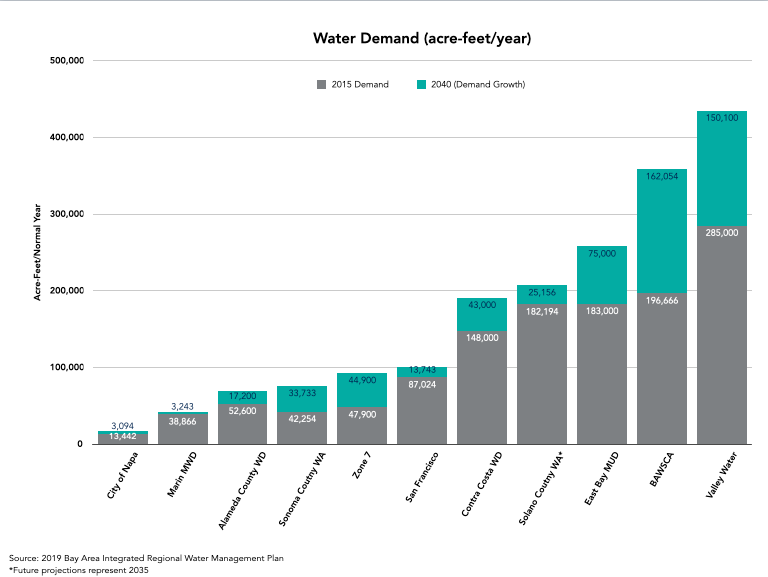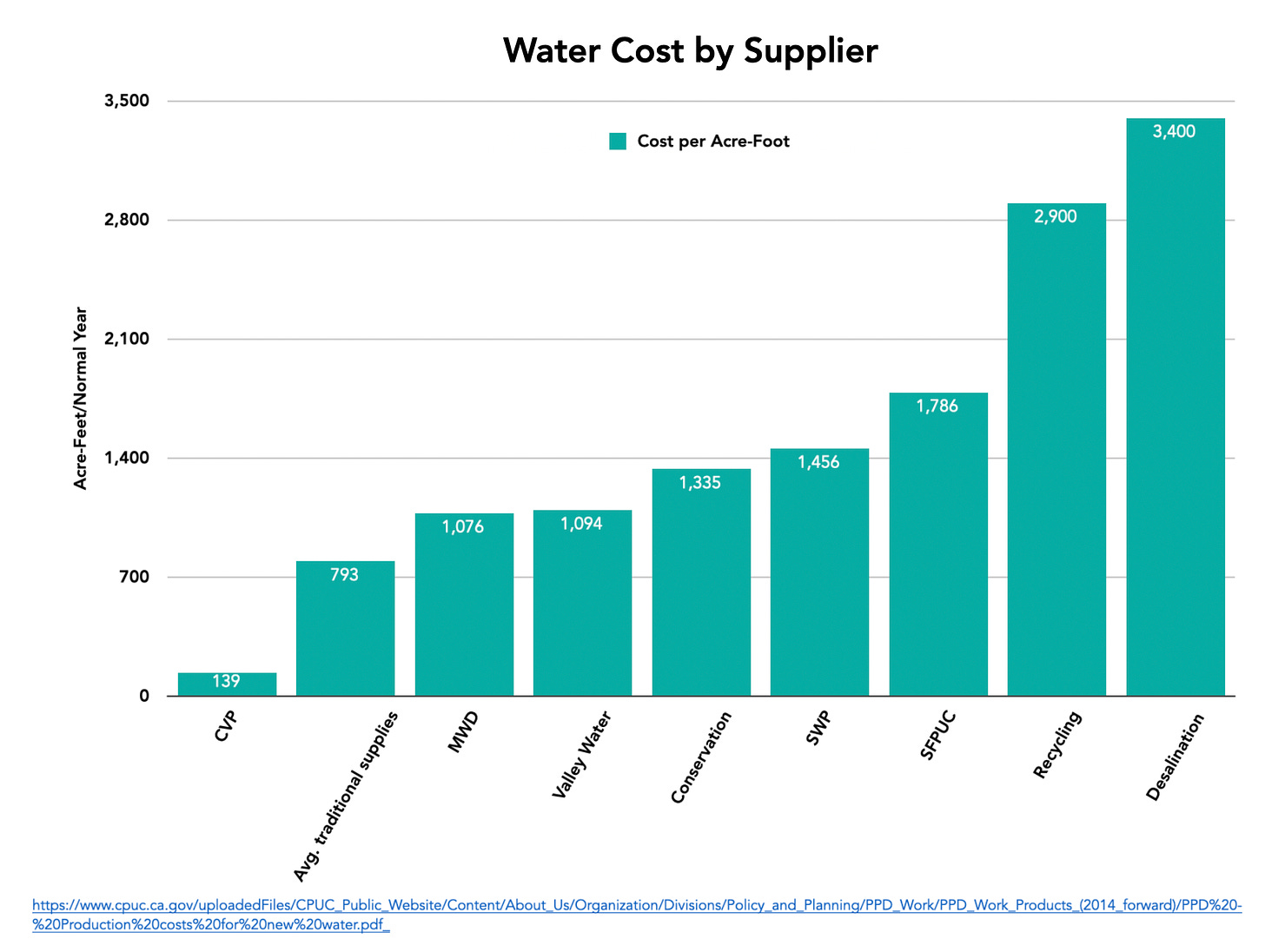How much would it cost to drought-proof the Bay Area?
Even a small risk of supply disruption warrants big investments in drought-proof water.
The rising frequency and intensity of droughts in California recently led the Los Angeles Times editorial board to run a provocative editorial that claimed there was no drought, only a hot, arid new normal. If that’s the case, does water insecurity threaten the Bay Area economy, and if so, what should we do about it?
First, it’s important to recognize that California’s economy has historically been extremely resilient to drought. The 2012 and 2016 drought was by some estimates the most severe in 1,200 years and killed an estimated 130 million trees that set the stage for wildfires of horrifying scale. Yet even during this record dry spell California’s real GDP grew at an average annual rate of 3.8 percent (compared to 2.3 percent nationally), and its population swelled by 1.2 million people. Many Californians, with the support of celebrities and athletes, were passionate about doing their part to reduce water use and together helped drive down water consumption an impressive 30 percent. By the time the rains returned, California’s Legislative Analyst Office estimated the drought had no significant effect on statewide economic activity or state revenues.
One big reason why California took the 2012-2016 drought in such stride was that the state is vastly more water efficient than it was a few decades ago. California’s total water use (including agriculture) peaked in 1995 and has been in steady decline ever since. At about 40 gallons per person per day, San Franciscans use less water than virtually anyplace in the developed world and produce more GDP per gallon consumed than anyplace else in the U.S. Three of the four most water-efficient metropolitan statical areas by GDP-per-gallon-consumed are in California, including San Jose and Los Angeles. And California keeps getting more efficient: residents entered the current drought using about 15 percent less water per capita than they did entering the previous one. In short, gains in conservation and efficiency have allowed California to add 10 million residents and nearly double its economy with only modest expansions to the state’s water infrastructure compared to the dam-and-aqueduct boom of the early and middle 20th century. This is an important achievement and should be celebrated more often.
Which brings us to the current drought. The Sierra Nevada Snowpack, which typically supplies about 66 percent of the Bay Area’s water supply, was 59 percent of normal as of April 1 this year. Not great, but not cataclysmic. What’s more worrisome is what happened next: a combination of hot, dry, and clear weather in the Sierras vaporized much of the snowpack into the atmosphere, leaving precious little to run off into streams and rivers. By May 11, the snowpack was just 6 percent its normal size. For the East Bay, that means reservoirs are at 62 percent capacity and residents have been asked to cut water use 10 percent voluntarily. Most Silicon Valley residents are under a mandatory 15 percent conservation order due to the double whammy of drought and the fact that their largest reservoir is empty for seismic improvements. Sonoma County, which is entirely dependent on local water supplies, received just 38 percent of its average rainfall and was the first county to receive an emergency drought declaration this year. The City of San Francisco, whose Hetch Hetchy reservoir is at ~80 percent capacity, is the only California county north of Ventura not in a declared drought emergency.
Interestingly, Southern California—traditionally the state’s most drought-prone region—is performing significantly better than most of the Bay Area so far. Part of the reason is natural—Southern California’s precipitation has been closer to average than much of the Bay Area’s these past two years. Another reason is that over the past 20 years Southern California has built one of the largest reservoirs in California, the largest desalination plant in the U.S., and one of the largest water recycling plants on earth. Some of these investments were criticized at the time for being expensive commitments to wasteful water use. After all, Southern California households use about 18 percent more water per day than their Bay Area counterparts. But these investments provide Southern California with a comforting buffer against climate disaster. The Bay Area, on the other hand, remains overwhelmingly reliant on old fashioned rain and snow. Just three percent of the Bay Area’s water supplies come from drought-proof sources.
Rather than a catastrophic water outage, the drought is more likely to cause indirect, self-inflicted economic harm by exacerbating the Bay Area’s affordability crisis. Consider Marin County, just north of San Francisco. Marin is a wealthy, water-efficient region (residents use about 14 percent less than state average) close to good-paying jobs. From a climate resilience perspective Marin is exactly the place where California should be incentivizing new growth. Yet Marin is today considering a moratorium on new connections due to dwindling water supplies. Marin could easily afford to invest in drought-resilient water, and in fact, has before: Marin built a small pilot desalination project to improve its drought resilience, but abandoned plans to expand the project in part due to a local fears that drought-proof water would promote housing development. For New York Times opinion page editors obligated every drought to run essays about California reaching its limits, Marin grew just five percent since 2000 compared to 19 percent statewide. Marin’s water shortage isn’t about natural limits, it’s about policy choices. Marin has chosen to remain entirely dependent on local rainfall despite knowing the risks because it’s more committed to NIMBYism. The commitment to no/slow-growth policies in Marin and elsewhere have turned much of California into a cruel gerontocracy with soaring housing costs, a fleeing working class, and enormous homeless population. Hence the self-inflicted economic harm.
In short, California’s urban economies have historically proven themselves to be highly drought resilient, but climate change makes it a risky bet to use past outcomes to predict future success. Furthermore, drought doesn’t have to be catastrophic to indirectly cause economic harm: you can be certain that a few Bay Area communities will attempt to use the drought to further slow or halt new housing construction while using the language of environmentalism to oppose investing in drought-resilient supplies. Not only would such new barriers exacerbate the region’s affordability crisis, it would also worsen the state’s climate and water challenges by pushing growth into California’s inefficient, fire-prone interior. To be a Californian concerned about drought and climate change is to support high density development as close to the ocean as possible.
The Bay Area should therefore vastly expand it’s supply of drought-resilient freshwater. An ambitious but achievable target would be 400,000 acre-feet annually, or about 30% of current demand. It’s also how much Bay Area water agencies predict demand will increase by 2040 given population projections (by which point 400,000 acre-feet would total 22 percent of total demand). That’s a lot of water, and reaching that amount will likely involve myriad projects of different scales in different parts of the region. For simplicity’s sake let’s take a look at two of the biggest options out there: desalination and wastewater recycling.
California today has 11 active sea water desalination plants which together generate about 54,000 acre-feet of freshwater each year (about .14% of annual statewide water use). The vast majority (88 percent) of desalinated water in California comes from a single project—the Carlsbad Desalination Plant—which supplies 7 percent of the freshwater for 3 million people in San Diego County. San Diego pursued the project as part of its strategy to reduce its reliance on imported supplies from Metropolitan Water District, which has provided as much as 95 percent of the county’s water. Most of California’s desalination plants produce less than 1,000 acre-feet of freshwater annually, typically to cool coastal power plants or to serve small seaside communities (like Santa Barbara, Monterey, and Cambria) with few other freshwater options. At least seven other desalination projects are currently in various stages of planning across California, which, if built, would have a cumulative production capacity of over 100,000 acre-feet per year, or about .27% of annual statewide water use. Of this planned increase in capacity, 56,000 acre-feet alone would come from a single project in Huntington Beach managed by Poseidon Water and the Orange County Water District. The Bay Area today has no active seawater desalination plants.
The biggest barrier to desalination is cost. Pushing city-sustaining volumes of saltwater through a reverse osmosis membrane (or to evaporate and condense in a thermal system) requires an extraordinary amount of energy, and that energy costs money. The California Public Utilities Commission estimates desalinated ocean water costs about $3,400 an acre-foot, more than any other source. More energy-efficient desalination technologies are under development right here in the Bay Area at Lawrence Berkley National Laboratories, but likely still 10 or more years away. Not surprisingly, the countries most reliant on desalination today—Kuwait (60%), Saudi Arabia (50%), Israel (50%), the UAE (42%)—either have abundant cheap energy, no other water alternatives, or both. There are also environmental concerns about desalination, especially the impact discharges of concentrated salty brine have on local marine wildlife. Maybe I’ll write about that in a future post, but for now let’s just focus on costs.
It would cost each Bay Area household about $45 per month to support the production of 400,000 acre-feet of desalinated water with existing technology. With the 2 million additional Bay Area residents the region is projected to have by 2040, the per-household cost of desalination would drop to about $36 per month.
Now let’s consider wastewater recycling. Between 2012 and 2019, Bay Area wastewater treatment plants discharged an annual average of 504,064 acre feet of effluent into San Francisco Bay. This, in my view, represents the Bay Area’s best untapped water resource. Well, mostly untapped: the Bay Area already has 35 wastewater recycling projects which recycle a combined 58,000 acre feet each year, just 14 percent of all urban recycled water in California. A single water recycling plant in Orange County alone recycles over 100,000 acre-feet annually. Recycled water in the Bay Area is projected to double over the next 20 years. It can and should be much more. Israel today meets about 25 percent of its total water demand by recycling 87 percent of its wastewater, more than any other country on earth. By contrast, the Bay Area would have to recycle 80 percent of its wastewater to produce 400,000 gallons of freshwater annually.
Assuming the Bay Area were to produce 400,000 acre feet of recycled wastewater with existing technology, and that operations costs were evenly distributed, it would cost each Bay Area household about $37 per month. With the 2 million additional Bay Area residents the region is projected to have by 2040, the per-household cost of desalination would drop to about $29 per month. Like desalination, the cost of recycled water is also expected to decline with technological advances. Unlike desalination, however, recycled water will get cheaper in near-term due to regulatory changes: the State Water Board will adopt rules for direct potable reuse by the end of 2023. This means recycled water plants would be able to either connect directly into the distribution system or discharge their recycled water into surface reservoirs rather than build and maintain an expensive parallel plumbing system specifically for recycled water as they are forced to do today.
It’s important to recognize any discussion of increased spending in California’s water sector is occurring against the backdrop of quickly rising water costs. The vast majority of Californians receive their water from at least one of the state’s six major water projects built between 1912 and 1971. Many components of these aging projects are reaching the end of their lives and have either been recently replaced, are currently being replaced, or need to be replaced. These improvements, plus other factors inflating infrastructure costs in the United States, have sent the cost of water in California skyrocketing. According to the water news agency Circle of Blue, between 2010 and 2018 water rates in San Diego increased 60 percent, rates in Los Angeles increased 87 percent, in San Jose 93 percent, and in San Francisco 141 percent. The high costs have left more Californians struggling to keep up, with residents owing an estimated $1 billion in back payments, with an estimated 12 percent of residents on the brink of service disconnection. Concerns about water affordability, and the legal constraints agencies face for using ratepayer dollars to help low-income households, means any proposals to invest in drought resilient supplies will be heavily scrutinized for ratepayer impacts.
By now some may be wondering why California doesn’t simply reallocate to cities water currently used by farmers? After all, California’s farming sector consumes about 80 percent of all freshwater used by humans yet generates just 1.65 percent of the state’s economy. Virtually all economic losses stemming from the 2012-2016 drought were from the farm sector, yet those totaled just .14 percent of California’s economy. The short answer is that would be anything but simple. For better or worse, the agricultural sector's control over much of California’s water resources is enshrined in a legal web of water rights dating back to the state’s agrarian, post-Gold Rush economy. Not that reforming California water rights shouldn’t be done, but it’s an enormously complex subject that would require its own post.
In conclusion, although the Bay Area economy is unlikely to sustain significant economic damage from the current drought, damages are more likely to occur than during the previous drought, and will continue increasing as demand hardens due to population growth and warming temperatures. Because the economic and social costs of actually running out of water are so high, and because droughts don’t need to be catastrophic to cause indirect economic harm, especially with regards to restrictions on housing, and because climate change cheapens the value of using past hydrology as a predictor of the future, the Bay Area should invest now in drought resilient supplies to cover projected increased demand. An ambitious but achievable target would be 400,000 acre-feet per year by 2040. Recycled water and sea water desalination are two technologically feasible ways of achieving drought resilient supplies on that magnitude, and are created at similar scales in other countries. Of the two, recycled water is the most cost-effective way to reach that goal, and its cost will be further reduced in the near-term by regulatory changes. Lastly, the state and federal governments should provide grants and low-interest loans to local and regional water agencies to build drought-resilient supplies to help offset the cost impacts of drought-proof supplies, especially on low-income households.




